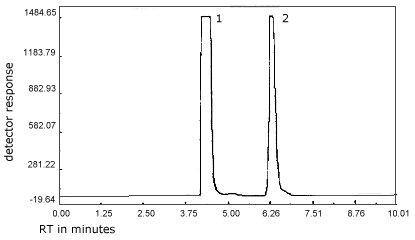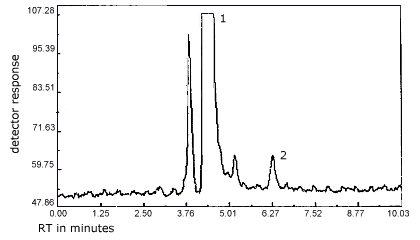![]()
| Method no.: | 85 |
| Matrix: | Air |
| Target concentration: | 50 ppm (175 mg/m3) |
| Procedure: | A sample is collected by drawing air through an open face air
monitoring cassette containing three glass fiber filters. Each
filter is coated with |
| Recommended air volume and sampling rate: |
3 L at 0.05 L/min |
| Reliable quantitation limit: | 174 ppb (613 µg/m3) |
| Standard error of estimate at the target concentration: (Section 4.7. ) |
7.57% |
| Special requirement: | Keep the samples in the dark whenever possible as a precaution against photodecomposition. |
| Status of method: | Evaluated method. This method has been subjected to the established evaluation procedures of the Organic Methods Evaluation Branch. |
| Date: July 1990 | Chemist: Warren Hendricks |
OSHA Analytical Laboratory
Salt Lake City, Utah
1. General Discussion
- 1.1 Background
- 1.1.1. History
This work was performed because there was no fully evaluated OSHA method for the sampling and analysis of valeraldehyde.
Experimental work showed that valeraldehyde could be efficiently
collected directly on Carbosieve
A sampling device similar to that used by OSHA to monitor
glutaraldehyde (Ref.
5.1.) and crotonaldehyde (Ref.
5.2.) was tested to determine if it would efficiently
collect and derivatize valeraldehyde. Those methods require sample
collection using two glass fiber filters
CH3CH2CH2CH2CHO |
+ |
(O2N)2C6H3NHNH2 |
acid |
| (O2N)2C6H3NHN
=
CHCH2CH2CH2CH3 |
+ | H2O |
Initial laboratory experiments showed that glass fiber filters coated with DNPH were also effective for the collection and derivatization of valeraldehyde. Three coated filters were required for adequate sampler capacity. It is necessary to provide more sampler capacity for valeraldehyde than for the other two aldehydes because the PEL for valeraldehyde is 50 ppm while those for glutaraldehyde and crotonaldehyde are 0.2 ppm and 2 ppm, respectively.
1.1.2. Toxic effects (This section is for information only and should not be taken as the basis of OSHA policy.)
Valeraldehyde has been shown to be a severe irritant to the skin
of guinea pigs and to the eyes of rabbits. Even though its
irritation properties are considerable, it has low systemic
toxicity. The dermal LD50for guinea pigs
and the oral LD50for rats and mice are
several grams per kilogram of body weight. The
LC50was reported to be about
1.1.3. Workplace exposure
Valeraldehyde is used in flavoring compounds, in resin chemistry and as rubber accelerators. (Ref. 5.3.)
1.1.4. Physical properties (Ref. 5.4.)
| CAS no. | 110-62-3 |
| molecular weight: | 86.13 |
| physical description: | colorless, flammable liquid |
| specific gravity: | 0.810 at 20°C |
| boiling point: | 103° |
| melting point: | -91° |
| vapor density: | 3.0 (air = 1) |
| vapor pressure: | 7 kPa (50 mmHg) at 25° |
| flash point: | 54° |
| chemical formula: | CH3CH2CH2CH2CHO |
| solubility: | slightly soluble in water; soluble in alcohol and ether |
| synonyms: |
The analyte air concentrations listed throughout this method are based on an air volume of 3 L and a solvent extraction volume of 15.0 mL. Air concentrations listed in ppm and ppb are referenced to 25° and 101.3 kPa (760 mmHg). The analyte concentrations are listed as valeraldehyde even though the derivative is the actual species analyzed.
1.2. Limit defining parameters
- 1.2.1. Detection limit of the analytical procedure
The detection limit of the analytical procedure is 1.23 ng per injection. This is the amount of valeraldehyde which will give a derivative peak with a height about 5 times the height of the baseline noise. (Section 4.1.)
1.2.2. Detection limit of the overall procedure
The detection limit of the overall procedure is 1.84 µg per sample (174 ppb or 613 µg/m3). This is the amount of valeraldehyde spiked on the sampler which allows recovery of an amount of analyte equivalent to the detection limit of the analytical procedure. (Section 4.2.)
1.2.3. Reliable quantitation limit
The reliable quantitation limit is 1.84 µg per sample (174 ppb or 613 µg/m3). This is the smallest amount of valeraldehyde which can be quantitated within the requirements of a recovery of at least 75% and a precision (±1.96 SD) of ±25% or better. (Section 4.3.)
The reliable quantitation limit and detection limits reported in the method are based upon optimization of the instrument for the smallest possible amount of analyte. When the target concentration of an analyte is exceptionally higher than these limits, they may not be attainable at the routine operating parameters.
1.2.4. Instrument response to the analyte
The instrument response over the concentration range of 0.5 to 2 times the target concentration is linear. (Section 4.4.)
1.2.5. Recovery
The recovery of valeraldehyde from samples used in a
1.2.6. Precision (analytical procedure)
The pooled coefficient of variation obtained from replicate determinations of analytical standards at 0.5, 1, and 2 times the target concentration is 0.018. (Section 4.6.)
1.2.7. Precision (overall procedure)
The
1.2.8. Reproducibility
Six samples collected from a controlled test atmosphere and a draft copy of this procedure were given to a chemist unassociated with the evaluation. The samples were analyzed after 46 days of storage at about 5°. No individual sample deviated from its theoretical value by more than the precision reported in Section 1.2.7. (Section 4.8.)
1.3. Advantage
This sampling and analytical procedure provides a simple and convenient means to monitor occupational exposure to valeraldehyde.
1.4. Disadvantage
The coated filters are not commercially available.
2. Sampling Procedure
- 2.1. Apparatus
- 2.1.1. A sample is collected by use of a personal sampling pump
that can be calibrated to within ±5% of the recommended 0.05 L/min
flow rate with the sampler in line.
2.1.2. A sample is collected using an open face air monitoring cassette containing 3 glass fiber filters. Two filters are stacked and are used as the primary collector. The third filter serves as a backup. The sections are separated and retained using cassette center sections (Figure 4.11.). Each filter is coated with DNPH and phosphoric acid. Instructions for the preparation of the coated filters and assembly of the sampler are given in Section 4.11. of this method.
2.2. Reagents
No sampling reagents are required.
2.3. Technique
- 2.3.1. Remove the inlet section (cover) and the end plug on the
exit section of the air monitoring cassette so that sampling is
performed open face.
2.3.2. Attach the sampler to the sampling pump with flexible, plastic tubing such that the front filter of the sampler is exposed directly to the atmosphere.
2.3.3. Attach the open face air monitoring cassette vertically (face down) in the worker's breathing zone in such a manner that it does not impede work performance or safety.
2.3.4. Remove the sampler after sampling for the appropriate
time. Replace the inlet section (cover) and the end plug on the exit
section of the air monitoring cassette. Wrap the sample
2.3.5. Keep collected samples in the dark whenever possible as a precaution against photodecomposition.
2.3.6. Submit at least one blank with each set of samples. The blank should be handled the same as the other samples except that no air is drawn through it.
2.3.7. List any potential interferences on the sample data sheet.
2.4. Sampler capacity
Sampler capacity was evaluated by sampling a controlled test
atmosphere with several of the recommended samplers for increasing
periods of time. Percent breakthrough was measured as the amount of
valeraldehyde found on the back filter relative to the total amount
collected on the entire sampler.
2.5. Extraction efficiency
- 2.5.1. The extraction efficiency for valeraldehyde from DNPH
coated glass fiber filters at the target concentration was 96.5%.
(Section
4.10.)
2.5.2. Extracted samples remain stable for at least 16 h. (Section 4.10.)
2.6. Recommended air volume and sampling rate
- 2.6.1. Sample 3 L of air at 0.05 L/min for TWA samples.
2.6.2. Sample 0.75 L of air at 0.05 L/min for
2.6.3. When
2.7. Interferences (sampling)
Any substance, present in the sampled air, that is capable of reacting with DNPH and thereby depleting the derivatizing reagent is a potential interference. Many aldehydes and ketones are capable of reacting with DNPH.
2.8. Safety precautions (sampling)
- 2.8.1. Attach the sampling equipment to the worker in such a
manner that it will not interfere with work performance or safety.
2.8.2. Follow all safety practices that apply to the work area being sampled.
3. Analytical Procedure
- 3.1. Apparatus
- 3.1.1. A
3.1.2. An HPLC column capable of resolving the
3.1.3. An electronic integrator or some other suitable means to
measure detector response. A
3.1.4. Vials, glass,
3.1.5. Volumetric flasks, pipets and syringes for preparing standards, making dilutions and performing injections.
3.1.6. Pipets, disposable, Pasteur-type.
3.1.7. A laboratory shaker or other suitable means to agitate the samples during extraction. An Eberbach laboratory shaker was used in this evaluation.
3.1.8. A laboratory centrifuge to clarify samples. A Damon/IEH
Division IEH
3.2. Reagents
- 3.2.1. Acetonitrile, HPLC grade. American Burdick and Jackson
Acetonitrile UV was used in this evaluation.
3.2.2. Water, HPLC grade. Water from a Millipore
3.2.3. Phosphoric acid, reagent grade. "Baker Analyzed" Reagent grade 85% phosphoric acid was used in this evaluation.
3.2.4. Valeraldehyde. Aldrich Chemical Company valeraldehyde (99%), lot no. 03923AW, was used in this evaluation.
3.2.5. 2,4-Dinitrophenylhydrazine (DNPH). DNPH (70%), lot no. 1707 LJ, was obtained from Aldrich Chemical Company and was recrystallized from hot acetonitrile for use in this evaluation.
3.2.6. Analytical standard preparation solution. This solution is prepared by diluting 0.27 g of recrystallized DNPH and 0.42 mL of phosphoric acid to 100 mL with acetonitrile.
3.3. Standard preparation
- 3.3.1. Prepare analytical standards the day before the air
samples are to be analyzed to ensure the complete reaction between
DNPH and valeraldehyde. Standards and samples should be kept in the
dark whenever possible as a precaution against photodecomposition.
3.3.2. Prepare valeraldehyde stock standard solutions by diluting 99% valeraldehyde with acetonitrile. A standard containing 8.1 mg/mL of valeraldehyde was prepared by diluting 24.55 mg of the 99% material to 3.0 mL with acetonitrile.
3.3.3. Place
3.3.4. Prepare analytical standards by injecting appropriate
volumes of valeraldehyde stock standard solutions (Section
3.3.2.) into the sealed
3.3.5. Prepare a sufficient number of standards to generate a calibration curve. Analytical standard concentrations must bracket sample concentrations.
3.4. Sample preparation
- 3.4.1. Open the air monitoring cassette and remove the front
coated filters. Transfer both filters to a single
3.4.2. Place the back filter in a separate
3.4.3. Add 15.0 mL of acetonitrile to each vial.
3.4.4. Seal the vials with Polyseal caps and place them on the laboratory shaker. Shake the samples for 1 h.
3.4.5. Place the samples in a laboratory centrifuge and spin them at approximately 2000 rpm for about 5 min. This process serves to clarify samples by centrifugation of glass fiber filter particulate.
3.4.6. Place about 3 mL of the clarified sample in a
3.5. Analysis
- 3.5.1. HPLC conditions
| column: | J.T. Baker Bakerbond CN, 25 cm × |
| mobile phase: | 45% acetonitrile in water containing 0.1% phosphoric acid (v/v/v) |
| flow rate: | 1 mL/min |
| injection volume: | 10 µL |
| UV detector: | 365 nm |
| retention time: | 6.3 min |
3.5.2. A chromatogram at the target concentration is shown in Figure 3.5.2.
3.5.3. Use a suitable method such as electronic integration to measure detector response (peak areas or heights).
3.5.4. Prepare a calibration curve by plotting the detector
response for each standard solution against its respective actual
concentration in micrograms of valeraldehyde per milliliter of
sample. Determine the
3.6. Interferences (analytical)
- 3.6.1. Any compound which produces a UV response at 365 nm and
has a similar retention time as the
3.6.2. HPLC parameters (mobile phase composition, column, analytical wavelength, etc.) may be changed to circumvent interferences.
3.6.3. Retention time on a single column is not proof of chemical identity. Analysis using an alternate HPLC column, detection at another wavelength, comparison of absorbance response ratios, and structure determination by mass spectrometry are additional means of identification.
3.7. Calculations
- 3.7.1. The concentration (micrograms of valeraldehyde per
milliliter) of samples is determined from the calibration curve. If
valeraldehyde is found on the back filter, it is added to the amount
found on the front filters. Blank corrections should be performed
before adding the results together.
3.7.2. The valeraldehyde air concentration can be expressed using the following equation:
| where | A = micrograms/milliliter (from Section
3.7.1.) B = extraction volume C = liters of air sampled E = extraction efficiency (decimal form) |
3.7.3. The following equation can be used to convert valeraldehyde results in mg/m3 to ppm at 25° and 101.3 kPa (760 mmHg):
| where | mg/m3
= 24.46 = 86.13 = | result from Section 3.7.2. molar volume at 101.3 kPa (760 mmHg) and 25° molecular weight of valeraldehyde |
3.8. Safety precautions (analytical)
- 3.8.1. Avoid skin contact and inhalation of all chemicals.
3.8.2. Restrict the use of all chemicals to a fume hood.
3.8.3. Wear safety glasses and a lab coat in all lab areas.
4. Backup Data
- 4.1. Detection limit of the analytical procedure
The injection size recommended in the analytical procedure (10 µL) was used to determine the detection limit of the analytical procedure. The detection limit of the analytical procedure was 1.23 ng per injection. This was the amount of valeraldehyde that gave a derivative peak with a height about 5 times the height of the baseline noise. This detection limit was determined by the analysis of a standard containing 0.123 µg/mL valeraldehyde. Figure 4.1. is a chromatogram of the detection limit of the analytical procedure.
4.2. Detection limit of the overall procedure
The detection limit of the overall procedure is 1.84 µg per sample (174 ppb or 613 µg/m3). The injection size recommended in the analytical procedure (10 µL) was used in the determination of the detection limit of the overall procedure. Six vials, each containing two coated glass fiber filters, were each liquid spiked with 1.84 µg of valeraldehyde. The samples were extracted about 16 h after being spiked.
|
| ||
| sample number |
theoretical amount (µg) |
amount recovered (µg) |
|
| ||
| 1 2 3 4 5 6 |
1.84 1.84 1.84 1.84 1.84 1.84 |
2.14 2.04 1.98 1.68 2.12 1.98 |
|
| ||
4.3. Reliable quantitation limit data
The reliable quantitation limit is also 1.84 µg per sample (174 ppb or 613 µg/m3). The injection size recommended in the analytical procedure (10 µL) was used in the determination of the reliable quantitation limit. Because the recovery of valeraldehyde from spiked samples (Section 4.2.) was greater than 75% and also because the precision (±1.96 SD) was less than ±25%, the detection limit of the overall procedure and reliable quantitation limit are the same.
|
| ||
| percent recovered |
statistics | |
|
| ||
| 116.3 110.9 107.6 91.3 115.2 107.6 |
SD = Precision = = |
108.2 9.0 (1.96)(±9.0) ±17.6% |
|
| ||
4.4. Instrument response to valeraldehyde
The instrument response to valeraldehyde over the range of 0.5 to 2 times the target concentration is linear with a slope of 148000 area counts per microgram per milliliter. The response to valeraldehyde was determined by multiple injections of standards. The data in Table 4.4. is presented graphically in Figure 4.4.
|
| |||
| × target concn µg/mL |
0.5× 17.6 |
1× 35.16 |
2× 69.9 |
|
| |||
| area counts | 2617660 2653770 2665640 2651630 2689340 2669780 |
5172740 5189320 5062230 5090860 5116790 5074880 |
10498100 10606800 10758300 10218100 10064300 10094900 |
| 2657970 | 5117803 | 10373416 | |
|
| |||
4.5. Storage test
Thirty-six samples were collected by sampling a test atmosphere
containing 200 mg/m3 valeraldehyde for about
1 h at 0.05 L/min. The relative humidity of the atmosphere was 75% at
25°. Eighteen of the samples were stored in a freezer at
|
| |||||||
| storage time (days) |
% recovery (ambient) |
% recovery (freezer) | |||||
|
| |||||||
| 0 0 4 7 11 14 19 |
100.3 95.8 96.5 106.4 100.7 102.6 91.6 |
95.9 95.9 91.7 91.0 89.0 81.4 93.8 |
94.3 93.0 92.5 91.6 83.6 92.4 93.1 |
100.3 95.8 101.4 95.4 93.7 94.2 92.2 |
95.9 95.9 97.7 92.9 95.0 93.8 96.6 |
94.3 93.0 92.0 92.7 93.9 90.4 92.3 | |
|
| |||||||
4.6. Precision (analytical method)
The precision of the analytical procedure is defined as the pooled coefficient of variation determined from replicate injections of valeraldehyde standards at 0.5, 1, and 2 times the target concentration.
|
| |||
| × target concn µg/mL |
0.5× 17.6 |
1× 35.16 |
2× 69.9 |
|
| |||
| SD1 CV |
23937.9 0.0090 |
52517.5 0.0103 |
288234.9 0.0278 |
|
1 standard deviation is in area counts | |||
4.7. Precision (overall procedure)
The precision of the overall procedure is determined from the storage data. The determination of the standard error of estimate (SEE) for a regression line plotted through the graphed storage data allows the inclusion of storage time as one of the factor affecting overall precision. The SEE is similar to the standard deviation except it is a measure of dispersion of data about a regression line instead of about a mean. It is determined with the following equation:

| where | n = k = k = |
total no. of data points 2 for linear regression 3 for quadratic regression |
| Yobs = | observed % recovery at a given time | |
| Yest = | estimated % recovery from the regression line at the same given time |
An additional ±5% for pump error is added to the SEE by the
addition of variances. The precision at the 95% confidence level is
obtained by multiplying the SEE (with sampling error included) by 1.96
(the
4.8. Reproducibility
Six samples, collected from a controlled test atmosphere were assigned to a chemist unassociated with this study. The concentration of the test atmosphere was 58 ppm valeraldehyde and the relative humidity was 81% at 24°. The samples were analyzed after 46 days of storage at about 5°. The sample results are corrected for extraction efficiency. No sample result had a percent deviation greater than the precision of the overall procedure, which was ±14.8%.
|
| |||
| µg collected | µg recovered | % recovered | % deviation |
|
| |||
| 603.3 583.0 589.0 623.6 576.9 625.6 |
597.5 613.9 611.4 665.4 639.2 667.8 |
99.0 105.3 103.8 106.7 110.8 106.7 |
-1.0 +5.3 +3.8 +6.7 +10.8 +6.7 |
|
| |||
4.9. Sampler capacity
Sampler capacity was evaluated by sampling a controlled test
atmosphere with several of the recommended samplers for increasing
periods of time. The valeraldehyde content of the test atmosphere was
297 mg/m3 and the relative humidity was 75%
at 28°. Percent breakthrough was measured as the relative amounts of
valeraldehyde collected on the front and back filters of the sampler.
|
| |
| air volume (L) |
breakthrough (%) |
|
| |
| 6.2 6.5 7.0 7.1 8.1 8.3 |
3.4 5.7 7.5 7.4 10.8 10.4 |
|
| |
4.10. Extraction efficiency and stability of extracted samples
The extraction efficiency for valeraldehyde was determined by liquid spiking DNPH coated glass fiber filters contained in separate glass vials (two filters per vial) with 40 µL of a solution containing 13.14 mg/mL of valeraldehyde in acetonitrile. These samples were stored at room temperature overnight and then extracted and analyzed. The average extraction efficiency was 96.5%. Following the initial analysis, the samples were resealed and reanalyzed about 16 h later using freshly prepared standards. The average of the reanalyzed samples was 100.6% of the original analysis.
|
| |
| extraction efficiency (%) |
reanalysis (%) |
|
| |
| 96.8 96.5 96.6 96.1 96.2 96.8 |
96.7 97.4 97.2 96.5 96.8 97.8 |
|
| |
4.11. Procedure to coat glass fiber filters with DNPH/phosphoric acid and to assemble the air sampler
- 4.11.1 Apparatus
- 4.11.1.1. Hotplate.
4.11.1.2. Miscellaneous glassware:
4.11.1.3. Plastic air monitoring cassettes, for
4.11.2. Reagents
- 4.11.2.1. Acetonitrile, HPLC grade. American Burdick and
Jackson Acetonitrile UV was used in this evaluation.
4.11.2.2. 2,4-Dinitrophenylhydrazine (DNPH). DNPH (70%), lot no. 1707 LJ, obtained from Aldrich Chemical Company, was recrystallized from hot acetonitrile for use in this evaluation.
4.11.2.3. Glass fiber filters,
4.11.2.4. Phosphoric acid, reagent grade. "Baker analyzed" Reagent grade 85% phosphoric acid was used in this evaluation.
4.11.2.5. DNPH/phosphoric acid solution. Prepare this solution by diluting 1.6 g of recrystallized DNPH and 2.5 mL of 85% phosphoric acid to 100 mL with acetonitrile. This solution may be saturated and a small amount of DNP may come out of solution.
4.11.3. Procedure
(CAUTION! Evaporation of acetonitrile must be performed in a fume hood.)
Place a glass fiber filter on a
Assemble the sampler by placing a coated filter in the outlet section of the air monitoring cassette. Next, place a center support section on the first filter. Now, put two coated filters on the center support section and another center support section on top of those filters. Complete the assembly by placing the inlet section on the center support section. Plug the outlet and inlet openings with plastic end plugs. An exploded view of the air sampler is shown in Figure 4.11. Put the air sampler on a table top with the outlet section down. Press on the top of the air sampler with sufficient force to seal the cassette. Use masking tape or shrink bands to further seal the cassette. Store the assembled air sampler at reduced temperature (when possible) if there is a significant delay before sampling. This is a precaution against sampling reagent decomposition.
4.12. Generation of controlled test atmospheres
The controlled test atmospheres were generated using a
valeraldehyde/water solution. The solution was prepared by adding 1 mL
of 99% valeraldehyde to 50 mL of water. This amount of valeraldehyde
was not completely soluble in 50 mL of water. The excess valeraldehyde
was removed by filtration through a Millipore Corporation
A test atmosphere was generated by pumping the aldehyde/water solution into a heated glass manifold with a Sage Instruments Model 355 Syringe Pump. The solution was volatilized and then diluted with heated air. The dilution air was metered into the heated glass manifold using a precision, calibrated rotameter. The test atmosphere passed through a manifold from which samples could be collected. The concentration of the test atmosphere was determined from the concentration of the aqueous valeraldehyde solution, the flow rate of the syringe pump, and the volume of the dilution air.
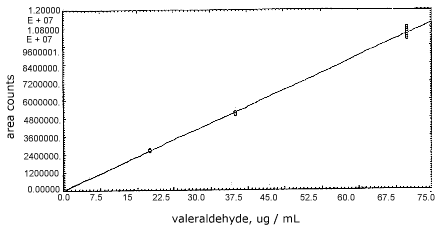
Figure 4.4. Calibration curve for
valeraldehyde.
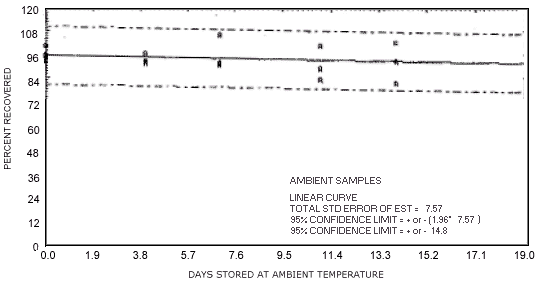
Figure 4.5.1. Ambient temperature storage test for
valeraldehyde.
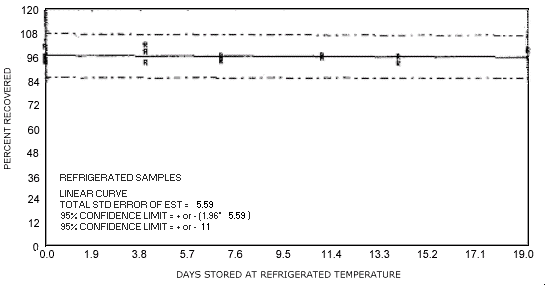
Figure 4.5.2. Refrigerated temperature storage test for
valeraldehyde.
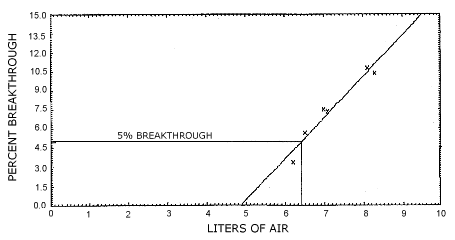
Figure 4.9. Sampler capacity for
valeraldehyde.
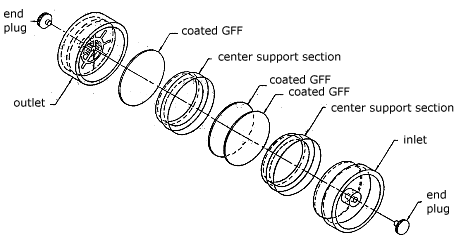
Figure 4.11. Sampling device for
valeraldehyde.
5. References
- 5.1. Hendricks, W. "OSHA Method No. 64;
Glutaraldehyde" OSHA Analytical Laboratory, unpublished, Salt Lake
City, UT 84165, June 1987.
5.2. Hendricks, W. "OSHA Method No. 81; Crotonaldehyde" OSHA Analytical Laboratory, unpublished, Salt Lake City, UT 84165, April, 1990
5.3. "Documentation of the Threshold Limit Values
and Biological Indices", 5th ed.; American Conference of Governmental
Industrial Hygienists (ACGIH): Cincinnati, ISBN:
5.4. ChemInfo Database on CCINFO CD-ROM disc
